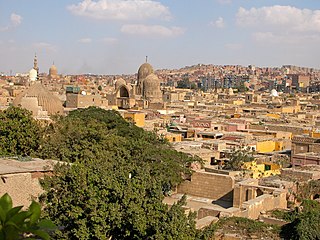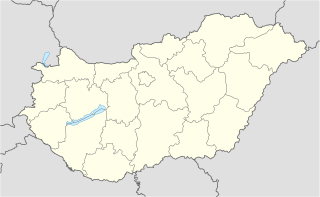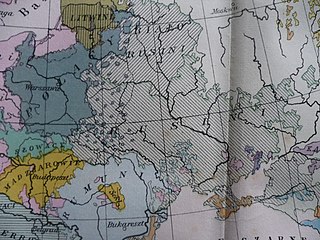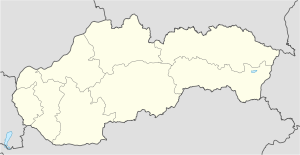
A cemetery or graveyard is a place where the remains of dead people are buried or otherwise interred. The word cemetery implies that the land is specifically designated as a burial ground and originally applied to the Roman catacombs. The term graveyard is often used interchangeably with cemetery, but a graveyard primarily refers to a burial ground within a churchyard.

Slavkov u Brna is a country town east of Brno in the South Moravian Region of the Czech Republic. Population: 6,456 (2011). The town gave its name to the Battle of Austerlitz which took place several kilometres to the west of the town.

The Natchez are a Native American people who originally lived in the Natchez Bluffs area in the Lower Mississippi Valley, near the present-day city of Natchez, Mississippi in the United States. They spoke a language with no known close relatives, although it may be very distantly related to the Muskogean languages of the Creek Confederacy.

Maple is a high-growth suburban community, part of the city of Vaughan, Ontario in York Region, northwest of Toronto, Ontario. As an unincorporated area, it does not have clearly defined geographic boundaries, but it grew around the former village of Maple, centred at the intersection of Major Mackenzie Drive and Keele Street in Vaughan.

Stari Mikanovci is a village in Croatia, located in the eastern part of the large Croatian historic and geographic region of Slavonia, situated in the westernmost part of the smaller Croatian historic and geographic region of Srijem.

Rescaldina is a comune (municipality) in the Province of Milan in the Italian region Lombardy, located about 25 kilometres (16 mi) northwest of Milan.

Rakowicki Cemetery is a cemetery in Poland, located in the centre of Kraków. It lies within the Administrative District No. 1 Stare Miasto meaning "Old Town" – distinct from with the historic Kraków Old Town further west. Founded at the beginning of the 19th century when the region was part of Austria-Hungary, the cemetery was expanded several times, and at present covers an area of about 42 hectares. Many notable Cracovians, among them the parents of Pope John Paul II, are buried here.

Upton Noble is a village and civil parish on the River Frome. It is roughly 4.5 miles (7 km) north-east of Bruton, and 7 miles (11 km) from Frome town centre, in the Mendip district of Somerset, England.

The City of the Dead, or Cairo Necropolis, is an Islamic necropolis and cemetery below the Mokattam Hills in southeastern Cairo, Egypt. The people of Cairo, the Cairenes, and most Egyptians, call it el'arafa. It is a 4 miles (6.4 km) long (north-south) dense grid of tomb and mausoleum structures, where some people live and work amongst the dead. Some reside here to be near ancestors, of recent to ancient lineage. Some live here after being forced from central Cairo due to urban renewal demolitions and urbanization pressures, that increased from the Gamal Abdel Nasser era in the 1950s and forward. Other residents immigrated in from the agricultural countryside, looking for work — an example of rural to urban migration in an LEDC. The poorest live in the City of the Dead slum, and Manshiyat Naser, which is also known as Garbage City, a center of recycling and reuse Zabbaleen vendors.

Baldenheim is a commune in the Bas-Rhin department in the Alsace region of north-eastern France.

Nárai is a village in Vas county, Hungary.

Svinařov is a village situated in a valley surrounded by forested slopes, fields and meadows. Approximately 667 people live there (2007). It is about 30 kilometres (20 mi) from Prague. Other towns close to Svinařov are Libušín, Kladno, Smečno and Slaný. The village is connected with the nearby towns and villages by bus. Svinařov has its own association football team and a team of firemen volunteers. Next to the cemetery, is a little chapel with a statue of St. Mary and Jesus from the 17th century.

Hazlov is a village and municipality in Cheb District in the Karlovy Vary Region of the Czech Republic. In 2008, it had a population of 1,665.

Nobility is a social class normally ranked immediately under royalty and found in some societies that have a formal aristocracy. Nobility possesses more acknowledged privileges and higher social status than most other classes in society. The privileges associated with nobility may constitute substantial advantages over or relative to non-nobles, or may be largely honorary, and vary by country and era. As referred to in the Medieval chivalric motto "noblesse oblige", nobles can also carry a lifelong duty to uphold various social responsibilities, such as honorable behavior, customary service, or leadership positions. Membership in the nobility, including rights and responsibilities, is typically hereditary.

The Samuel Danford Farm is a historic complex of buildings in northeastern Noble County, Ohio, United States. Located near the village of Summerfield, the complex comprises six buildings and one other site in an area of approximately 7.5 acres (3.0 ha).

The shliakhta were a noble class of ethnic Ukrainians in what is now western Ukraine, that enjoyed certain legal and social privileges. Estimates of their numbers vary. According to one estimate, by the mid-nineteenth century there were approximately 32,000 Ukrainian nobles in the western Ukrainian territory of Galicia, over 25% of whom lived in 21 villages near the town of Sambir. They comprised less than 2% of the ethnic Ukrainian population. Other estimates place the number of nobles at 67,000 people at the end of the 18th century and 260,000 by the end of the nineteenth century, or approximately 6% of the ethnic Ukrainian population. The nobles tended to live in compact settlements either in villages populated mostly by nobles or in particular areas of larger villages.

Starina is a former Ruthenian village in eastern Slovakia, within Snina District. The first mention of the village was in 1557. The village originally belonged to the noble families of Humenné. The inhabitants of the village were evacuated in 1980, along with six other villages, in order to make way for the Starina reservoir. Only one building and the cemetery remain. The village is now under the water level of the dam. Below the Magura mountain is a mineral water source. Now the territory is in the Poloniny National Park. On the territory, there is also the Gazdoráň Nature Reserve, which was declared for the protection of rare plants.

Smolník was a Ruthenian village in eastern Slovakia, within Snina District. The first mention of the village was in 1568. In 1980 the village was destroyed, along with six other villages, to make way for the Starina reservoir. Before its destruction, it had 72 houses and approximately 360 people. The village originally belonged to the noble families of Humenné, which was later given to some other noble families. There remains a cemetery of people killed during World War I and a bell tower. The territory is within Poloniny National Park.

Veľká Poľana is a former Ruthenian village in eastern Slovakia, in Snina District. The first mention of the village was in 1493. The village originally belonged to the noble families of Humenné, later given to some other noble families. The village was destroyed to make way for the Starina reservoir, along with six other villages. The only things remaining are a World War I cemetery, the village cemetery and a cottage. The territory now lies within Poloniny National Park.

Zvala is a former Ruthenian village in eastern Slovakia, within the Snina District. The first mention of the village was in 1543. The village originally belonged to the noble families of Humenné, later given to some other noble families. The village was destroyed in 1986 to make way for the Starina reservoir, along with six other villages. The only things remaining are the village cemetery and one house. Now the territory lies within Poloniny National Park.



















